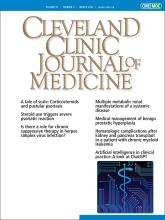Article Figures & Data
Tables
Tests Resultsa Reference range Sodium 148 mmol/L 136–145 Potassium 3.1 mmol/L 3.5–5.1 Chloride 115 mmol/L 98–107 Bicarbonate 20 mmol/L 21–32 Blood urea nitrogen 24 mg/dL 7–18 Creatinine 1.0 mg/dL 0.6–1.3 Glucose 74 mg/dL 60–99 Calcium 9.2 mg/dL 8.4–10.5 Hemoglobin 10.2 g/dL 13.9–16.3 White blood cell count 5.99 × 109/L 4.5–11.0 Neutrophils 67.6% 46.2%–80% Lymphocytes 18.5% 10.3%–40.5% Monocytes 12.7% 3.0%–14% Eosinophils 1.0% 0.0%–-5.0% Basophils 0.2% 0.0%–1.0% Platelet count 311 × 109/L 150–350 Alanine aminotransferase 50 U/L 6–65 Aspartate aminotransferase 26 U/L 3–37 Alkaline phosphatase 87 U/L 45–117 Bilirubin, total < 0.2 mg/dL 0.2–1.2 Albumin 3.7 g/dL 3.5–5.0 Magnesium 2.3 mg/dL 1.8–2.4 Serum osmolality 303 mOsm/kg 275–295 Phosphorus 2.1 mg/dL 2.5–4.9 Thyrotropin 1.59 mIU/L 0.5–4.5 Arterial blood gasses pH 7.34 7.35–7.45 Partial pressure of carbon dioxide 40 mm Hg 35–45 Partial pressure of oxygen 95 mm Hg 75–100 Urine Random sodium 67 mmol/L 20–214 Random potassium 8 mmol/L 17–95 Random chloride 53 mmol/L 24–255 Random urea 207 mg/dL 132–1,629 Osmolality 165 mOsm/kg 50–1,200 ↵a Abnormal results are in boldface.
Primary distal renal tubular acidosis
Sporadic (idiopathic)
Inherited (due to a congenital mutation)Secondary distal renal tubular acidosis
Hypergammaglobulinemia
Autoimmune disorders (eg, lupus erythmatosus, Sjögren syndrome, rheumatoid arthritis)
Chronic renal allograft rejection
Obstructive uropathy
Medullary sponge kidney
Autoimmune hepatitis
Primary biliary cholangitis
Lithium, amphotericin B, ifosfamide
Sickle cell anemiaBased on information in reference 2.
Tests Results Normal range Antinuclear antibody 1:80 < 40 = Negative dsDNA antibody Negative Titers < 10 = Negative Anti-Ro52 (SS-A) IgG 366 < 20 Anti-La (SS-B) antibody < 3 < 20 Anti-Ro60 IgG < 5 < 20 Cryoglobulin Negative Negative ds = double strand; Ig = immunoglobulin; SS = Sjögren syndrome
- TABLE 4
2016 American College of Rheumatology (ACR) and European Alliance of Associations for Rheumatology (EULAR) classification for primary Sjögren syndrome
Inclusion criteria Exclusion criteria At least 1 symptom of ocular or oral dryness, defined as a positive response to at least 1 of the following questions: Have you had daily, persistent, troublesome dry eyes for more than 3 months?
Do you have a recurrent sensation of sand or gravel in the eyes?
Do you use tear substitutes more than 3 times a day?
Have you had a daily feeling of dry mouth for more than 3 months?
Do you frequently drink liquids to aid in swallowing dry food?
Or suspicion of Sjögren syndrome based on glandular enlargement or the presence of characteristic extraglandular involvementPrior diagnosis of any of the following conditions: History of head and neck radiation treatment
Active hepatitis C infection (with positive polymerase chain reaction)
Acquired immunodeficiency syndrome
Sarcoidosis
Amyloidosis
Graft-vs-host disease
Immunoglobulin G4-related disease
ACR/EULAR classification criteria for primary Sjögren syndromea Criteria Score ACR/EULAR classification criteria for primary Sjögren syndrome 3 Anti-Ro/SS-A positive 3 Ocular staining score ≥ 5 (or van Bijsterveld score ≥ 4) in at least 1 eye 1 Schirmer test ≤ 5 mm at 5 minutes in at least 1 eye 1 Unstimulated whole saliva flow rate ≤ 0.1 mL/minute 1 ↵a The classification of primary Sjögren syndrome applies to any patient who meets the inclusion criteria, does not have any of the conditions listed as exclusion criteria, and has a score ≥ 4.
Adapted from reference 7.






